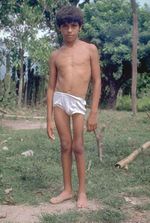Hesperian Health Guides
Paralysis Caused by Polio
 |
| Paralysis in one leg |
Polio (poliomyelitis) is caused by a virus that attacks parts of the spinal cord, where it damages only the nerves that control movement. In areas with poor sanitation, like lack of latrines, the polio infection spreads when virus in the stool (shit) of a sick child reaches the mouth of a healthy child. Polio also spreads through coughing and sneezing. For many years and in many countries, polio was the most common cause of physical disability in children. Vaccination programs have ended polio in most countries, but it is still a problem in Afghanistan and Pakistan.

Polio most often affects children under 5 years old. Most children who become infected with polio do not have symptoms of the infection. Only a small percentage of children who become infected with the polio virus become paralyzed: about 1 out of every 100 to 150 children who are exposed to the virus. Most children who have symptoms only get what looks like a bad cold, with fever, vomiting, or diarrhea. A child does not have to have symptoms to spread the polio virus to others.
 |
| Severe paralysis |
For children who develop paralysis, it begins after signs of a cold and fever, sometimes with diarrhea or vomiting. After a few days, the neck becomes stiff and painful and parts of the body become limp. Parents may notice the weakness right away, or only after the child recovers from the cold. Often the paralysis will gradually go away, partly or completely. Any paralysis left after 7 months is usually permanent. Certain secondary disabilities may develop, especially if precautions are not taken to prevent them. Children with paralysis due to polio can lead happy lives if they are encouraged to do things for themselves, to get the most out of school, and to learn useful skills within their physical abilities. Polio is not inherited (familial) and does not affect a person’s ability to have children. For more information on polio, see Other Resources.


